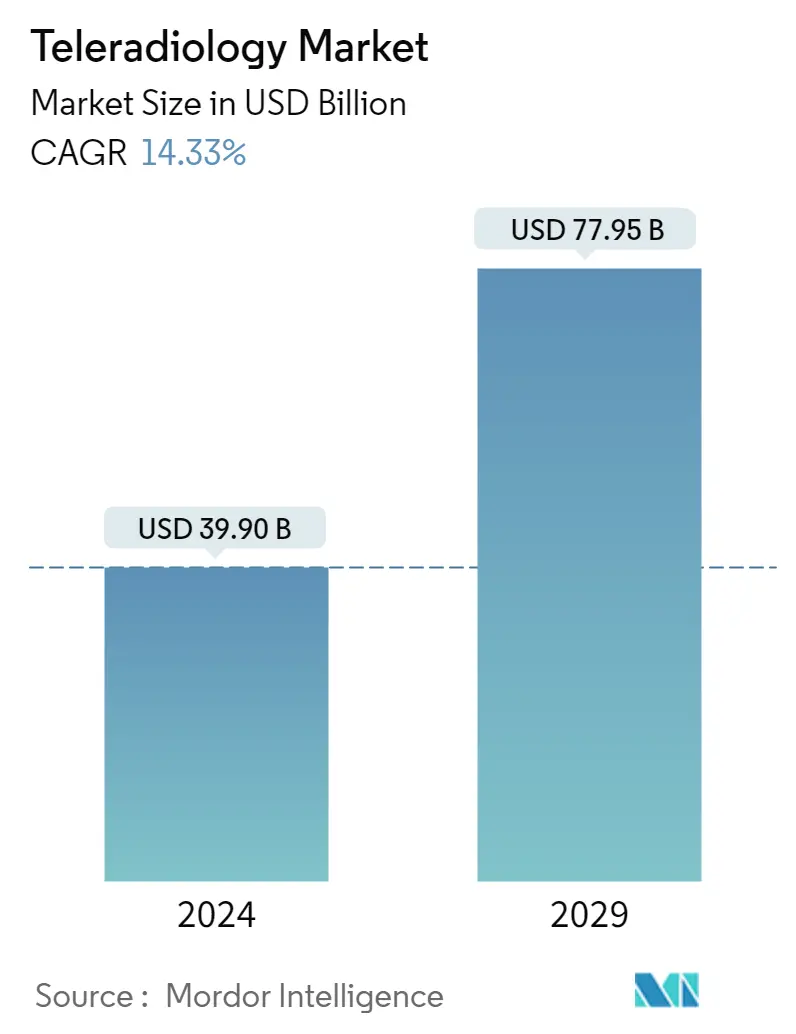Market Size of Teleradiology Industry

| Study Period | 2019 - 2029 |
| Market Size (2024) | USD 39.90 Billion |
| Market Size (2029) | USD 77.95 Billion |
| CAGR (2024 - 2029) | 14.33 % |
| Fastest Growing Market | Asia-Pacific |
| Largest Market | North America |
Major Players
*Disclaimer: Major Players sorted in no particular order |
Teleradiology Market Analysis
The Teleradiology Market size is estimated at USD 39.90 billion in 2024, and is expected to reach USD 77.95 billion by 2029, growing at a CAGR of 14.33% during the forecast period (2024-2029).
The COVID-19 pandemic has continued to transform the growth of various markets, and the immediate impact of the outbreak had varied. While a few industries registered a drop in demand, numerous other markets may continue to remain unscathed and show promising growth opportunities. During the pandemic, teleradiology systems were widely adopted to share study observations and detailed information gathered during the treatment of COVID-19 patients. This has helped prevent exchanging hard copies of imaging results and avoid in-person contact. For instance, as per the article published by NCBI in March 2021, the use of teleradiology to evaluate the effects of lockdown on a particular number of emergency sectors appeared beneficial, and the teleradiology platform can manage numerous emergency departments (ER) across the territory.
Furthermore, initially, due to the lockdown and hold on elective imaging services, there was a decrease in teleradiology services being observed. However, post-pandemic teleradiology has been accepted widely since it bridges the gap in imaging services between rural and non-rural areas. Patients in regions that lack local radiologists can still get diagnostic radiology services through radiologists working remotely through the services provided by teleradiology. Thus, as per the facts mentioned above, COVID-19 significantly impacted the teleradiology market and is expected to do the same during the forecast period.
The major factors responsible for the growth of the teleradiology market include the rising number of imaging procedures, the development of IT infrastructure, the rise in healthcare expenditure, and the increasing prevalence of osteoarthritis and chronic diseases. For instance, as per the article published by the American Cancer Society Journal in January 2022, approximately 1.9 million cancer cases were reported in the United States in 2022. The rising prevalence of chronic conditions, such as cancer, is increasing the diagnostic imaging procedural rate. Hence, the rising number of imaging procedures may boost the demand for reliable and efficient teleradiology solutions, resulting in high growth in the market.
Additionally, the increasing healthcare expenditure is positively influencing the overall market growth. For instance, as per the National Health Expenditure Projections 2023-2024, growth rates in United States health expenditures are projected to be 5% in the current year and 5.1% in the next year. as patient care patterns are assumed to revert to pre-pandemic levels. Teleradiology solutions have demonstrated the ability to enhance health outcomes and reduce costs. Telemedicine has been decreasing the cost of healthcare while increasing efficiency through improved management of chronic diseases, reduced travel times, and fewer and shorter hospital stays.
Moreover, the active participation of prominent players in the launch of various teleradiology platforms is also burgeoning the market growth. For instance, in August 2022, 5C Network launched its artificial intelligence-powered platform Prodigi to interpret radiology images directly from the cloud. This state-of-the-art platform enables teleradiology at a massive scale and makes it possible for diagnostic centers and hospitals to submit scans and access reports. Thus, such developments made by prominent players are projected to burgeon market growth during the forecast period.
Thus, as per the abovementioned factors, the teleradiology market is anticipated to grow over the forecast period. However, the lack of skilled professionals and security concerns associated with teleradiology restrain the market growth.
Teleradiology Industry Segmentation
Teleradiology is the transmission of images such as X-rays, CTs, and MRIs to share information with radiologists or physicians from one location to another. The teleradiology market is segmented by Imaging Technique [X-rays, computed tomography (CT), ultrasound, magnetic resonance imaging (MRI), nuclear imaging, and other imaging techniques], component (hardware and software), end user (hospitals, diagnostic centers, and other end users), and geography (North America, Europe, Asia-Pacific, Middle East and Africa, and South America). The market report also covers the estimated market sizes and trends for 17 countries across major regions globally. The report offers the value (in USD) for the above segments.
| By Imaging Technique | |
| X-rays | |
| Computed Tomography (CT) | |
| Ultrasound | |
| Magnetic Resonance Imaging (MRI) | |
| Nuclear Imaging | |
| Other Imaging Techniques |
| By Component | |
| Hardware | |
| Software |
| By End User | |
| Hospitals | |
| Diagnostic Centers | |
| Other End Users |
| Geography | ||||||||
| ||||||||
| ||||||||
| ||||||||
| ||||||||
|
Teleradiology Market Size Summary
The teleradiology market is poised for significant growth, driven by the increasing demand for remote healthcare services and advancements in IT infrastructure. The COVID-19 pandemic has accelerated the adoption of teleradiology, as it facilitated the sharing of imaging results without physical contact, thereby enhancing safety and efficiency. This technology has proven particularly beneficial in bridging the gap in diagnostic services between urban and rural areas, where local radiologists may be scarce. The market is further bolstered by the rising prevalence of chronic diseases, such as cancer and osteoarthritis, which necessitate a higher volume of imaging procedures. As healthcare expenditure continues to rise, teleradiology solutions are becoming integral in improving health outcomes while reducing costs, making them a vital component of modern healthcare delivery.
The software segment of the teleradiology market is experiencing robust growth due to technological advancements, including the integration of artificial intelligence and machine learning, which enhance diagnostic accuracy and speed. These innovations are addressing challenges such as radiologist shortages and are supporting initiatives in population screening and emergency care. The market's expansion is also supported by active participation from key players launching new platforms and solutions, as well as government initiatives promoting remote healthcare services. Geographically, North America holds a significant share of the market, driven by a well-developed healthcare infrastructure and substantial investments in biomedical imaging. The presence of numerous market players and ongoing product developments are expected to further propel the teleradiology market's growth over the forecast period.
Teleradiology Market Size - Table of Contents
-
1. MARKET DYNAMICS
-
1.1 Market Overview
-
1.2 Market Drivers
-
1.2.1 Rising Number of Imaging Procedures
-
1.2.2 Development of IT Infrastructure and Rise in Healthcare Expenditure
-
1.2.3 Increasing Prevalence of Osteoarthritis and Chronic Diseases
-
-
1.3 Market Restraints
-
1.3.1 Lack of Skilled Professionals
-
1.3.2 Security Concerns Associated with Teleradiology
-
-
1.4 Porter's Five Forces Analysis
-
1.4.1 Bargaining Power of Suppliers
-
1.4.2 Bargaining Power of Buyers/Consumers
-
1.4.3 Threat of New Entrants
-
1.4.4 Threat of Substitute Products
-
1.4.5 Intensity of Competitive Rivalry
-
-
-
2. MARKET SEGMENTATION (Market Size by Value - USD)
-
2.1 By Imaging Technique
-
2.1.1 X-rays
-
2.1.2 Computed Tomography (CT)
-
2.1.3 Ultrasound
-
2.1.4 Magnetic Resonance Imaging (MRI)
-
2.1.5 Nuclear Imaging
-
2.1.6 Other Imaging Techniques
-
-
2.2 By Component
-
2.2.1 Hardware
-
2.2.2 Software
-
-
2.3 By End User
-
2.3.1 Hospitals
-
2.3.2 Diagnostic Centers
-
2.3.3 Other End Users
-
-
2.4 Geography
-
2.4.1 North America
-
2.4.1.1 United States
-
2.4.1.2 Canada
-
2.4.1.3 Mexico
-
-
2.4.2 Europe
-
2.4.2.1 Germany
-
2.4.2.2 United Kingdom
-
2.4.2.3 France
-
2.4.2.4 Italy
-
2.4.2.5 Spain
-
2.4.2.6 Rest of Europe
-
-
2.4.3 Asia-Pacific
-
2.4.3.1 China
-
2.4.3.2 Japan
-
2.4.3.3 India
-
2.4.3.4 Australia
-
2.4.3.5 South Korea
-
2.4.3.6 Rest of Asia Pacific
-
-
2.4.4 Middle East and Africa
-
2.4.4.1 GCC
-
2.4.4.2 South Africa
-
2.4.4.3 Rest of Middle East and Africa
-
-
2.4.5 South America
-
2.4.5.1 Brazil
-
2.4.5.2 Argentina
-
2.4.5.3 Rest of South America
-
-
-
Teleradiology Market Size FAQs
How big is the Teleradiology Market?
The Teleradiology Market size is expected to reach USD 39.90 billion in 2024 and grow at a CAGR of 14.33% to reach USD 77.95 billion by 2029.
What is the current Teleradiology Market size?
In 2024, the Teleradiology Market size is expected to reach USD 39.90 billion.

